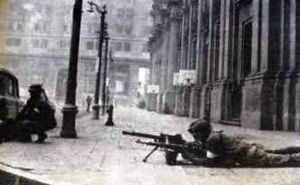Tanquetazo
| Tanquetazo | |||||||||
|---|---|---|---|---|---|---|---|---|---|
| Part of the Cold War | |||||||||
 Two Chilean soldiers with a machine gun lay at the south side of La Moneda during the attempted coup. |
|||||||||
|
|||||||||
| Government-Insurgents | |||||||||
| Chilean Government | Roberto Souper | ||||||||
| Commanders and leaders | |||||||||
| Salvador Allende | Lieutenant Colonel Roberto Souper | ||||||||
| Political support | |||||||||
| All parties in Congress of Chile | Fascist Movement "Patria y Libertad" | ||||||||
| Military support | |||||||||
| Almost all Chilean Armed Forces | Second Armored Battalion | ||||||||
El Tanquetazo or El Tancazo (both Spanish for "tank putsch") of 29 June 1973 are the names used to refer to the failed coup attempt in Chile led by Lieutenant Colonel Roberto Souper against the government of Socialist president Salvador Allende. It is called such because the rebelling officers primarily used tanks. It was successfully put down by loyal Constitutionalist soldiers led by Army Commander-in-Chief Carlos Prats.
By the beginning of June 1973, an important part of the high command of the Chilean Armed Forces had lost all respect for the Popular Unity government of President Salvador Allende, which had been in office since November 1970. During the so-called Tacnazo of 1969, high-ranking officers had learned that by exerting pressure as a group, they could achieve wide-ranging changes within the military. In 1969 they had achieved high command changes and an increase in the Armed Forces' budget. In June 1973, some began plotting against the Allende government.
A week before the coup attempt, the conspiracy was discovered at the Santiago Army garrison. The garrison commander, General Mario Sepúlveda Squella, informed his immediate superiors at the Army General Staff, and also told José Tohá, the Minister of Defense. The government immediately arrested nine people involved in the conspiracy, and Minister Tohá decided to go public with this information on the afternoon of 28 June.
Early in the morning of the following day, Lieutenant Colonel Roberto Souper, who had just learned that he would be relieved of his command for his part in the conspiracy, led a column of sixteen armored vehicles, including six Sherman tanks, plus 80 soldiers from the Second Armored Battalion in Santiago. The rebel column rapidly traveled to downtown Santiago and encircled the presidential palace, La Moneda, and the building housing the Ministry of Defense, just across the Plaza de la Libertad. At two minutes before 9:00 AM, the tanks opened fire on these buildings.
...
Wikipedia
